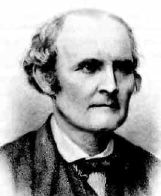

Arthur Cayley showed great skill in numerical calculations at school and his aptitude for advanced mathematics was apparent. His mathematics teacher advised that Arthur be encouraged to pursue his studies in this area rather than follow his father's wishes to enter the family business
as merchants.
In 1838, Arthur began his studies at Trinity College, Cambridge from where he graduated in 1842. While still an undergraduate he had three papers published
in the newly founded Cambridge Mathematical Journal edited by Duncan Gregory.
For four years he taught at Cambridge having won a Fellowship and, during this period, he published 28 papers in the Cambridge Mathematical Journal.
A Cambridge fellowship had a limited tenure so Cayley had to find a profession. He chose law and was admitted to the bar in 1849. He spent 14 years as a
lawyer but Cayley, although very skilled in the legal specialty of conveyancing, always considered it as a means to make money so that he could pursue mathematics.
While still training to be a lawyer Cayley went to Dublin to hear Hamilton lecture on quaternions. He sat next to Salmon during these lectures and the two
were to exchange mathematical ideas over many years. Another of Cayley's friends was Sylvester who was also in the legal profession. The two both worked
at the courts of Lincoln's Inn in London and they discussed deep mathematical questions during their working day. During his years as a lawyer, Cayley
published about 250 mathematical papers.
In 1863 Cayley was appointed Sadleirian professor of Pure Mathematics at Cambridge. This involved a very large decrease in income for Cayley who now
had to manage on a salary only a fraction of that which he had earned as a skilled lawyer. However Cayley was very happy to have the chance to devote
himself entirely to mathematics.
He published over 900 papers and notes covering nearly every aspect of modern mathematics. The most important of his work is in developing the algebra of matrices, work in non-Euclidean geometry and n-dimensional geometry.
As early as 1849 Cayley a paper linking his ideas on permutations with Cauchy's. In 1854, Cayley wrote two papers which are remarkable for the insight they
have of abstract groups. At that time the only known groups were permutation groups and even this was a radically new area, yet Cayley defines an abstract
group and gives a table to display the group multiplication. He gives the "Cayley tables" of some special permutation groups but, much more significantly for
the introduction of the abstract group concept, he realised that matrices and quaternions were groups.
Cayley developed the theory of algebraic invariance, and his development of n-dimensional geometry has been applied in physics to the study of the
space-time continuum. His work on matrices served as a foundation for quantum mechanics, which was developed by Werner Heisenberg in 1925. Cayley
also suggested that euclidean and non-euclidean geometry are special types of geometry. He united projective geometry and metrical geometry which is
dependent on sizes of angles and lengths of lines.
In 1881 he was invited to give a course of lectures at Johns Hopkins University in the USA, where his friend Sylvester was professor of mathematics. He spent the first half of 1882 at Johns Hopkins University where he lectured on Abelian and Theta Functions.